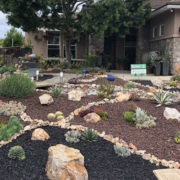When choosing new plants for your landscape this fall, be sure to account for the space each plant will need as it matures. This will help avoid overcrowding in your landscape.
Proper plant placement, while predicting the mature plant’s size, also should limit the need for future pruning. This can help reduce the amount of maintenance required in the long run.
The spacing chart below helps to judge how many plants are needed per square foot, based on the mature size of the plants.

Plan for space needed at maturity
On your landscaping plan, use circles to note the size of every plant at maturity using a scale in which one inch equals four feet. Use colored pencils to note different water needs of each plant. That will make it easier to group plants into their proper irrigation zones (hydrozones).
Wide canopy trees that grow to 20 or 30 feet in diameter will significantly change the landscaping over time. Consider whether a tree will cover a large section of landscaping with shade that is currently getting full sun. Be sure to avoid placing plants that will need full sun underneath these trees.
Small but mighty
Select the smallest, healthiest plants possible, especially when choosing native plants. Once they are planted in properly prepared soil and watered wisely, small plants establish themselves more vigorously than plants raised in larger containers. Do not plant more than the space will allow for when the plants are fully grown.
Root depth matters
Take note of the root depth of plants when you place them. Note root depths on your landscape plan. Trees will be irrigated less frequently, but for a longer period of time. Groundcovers with shallower roots require more frequent, shorter periods of irrigation. Keep these types of plants in separate hydrozones.
Did you know that fall is the prime time for plant sales in San Diego County? Check out your nearest nursery or farmers market for native plants to help grow your landscape!
This article was inspired by the 71-page Sustainable Landscapes Program guidebook available at SustainableLandscapesSD.org. The Water Authority and its partners also offer other great resources for landscaping upgrades, including free WaterSmart classes at WaterSmartSD.org.




